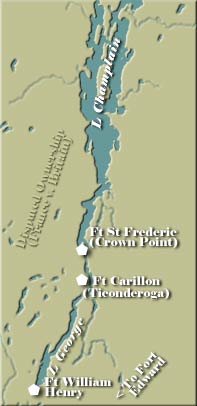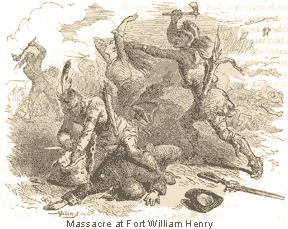In the 1750s, the European imperial powers in North America, France and Britain, faced one another as rivals in the greater Lake Champlain region, an area of economic and strategic value to both. Fort Carillon, located between lakes Champlain and George (Lac du Saint Sacrement to the French) was the southernmost outpost of New France. The closest British position was Fort Edward on the banks of the upper Hudson River to the southeast.
The British gradually increased their presence in the Lake George area and by 1757 had completed a road through the dense forest from Fort Edward. In late summer of that year, a French army unsuccessfully attacked British forces under William Johnson on the south shore of the lake. The victors solidified their position by constructing the wood-walled Fort William Henry, which was designed to serve as a base of operations for future campaigns against French positions to the north.
 During 1756, both sides increased their troop strength on the lakes and conducted small raids against each other. In the following year, the French commander at Fort Carillon, the Marquis de Montcalm, decided to end the stalemate and moved against William Henry. His army numbered more than 7,000 — French regulars, Canadian militia and native warriors from several dozen tribes. The French had stirred Indian interest by promises of great plunder to be gained in the conquest.
British General Daniel Webb had visited Fort William Henry, but withdrew to the safer confines of Fort Edward after receiving reports of the advent of the large French army. Lieutenant Colonel George Munro (Monro) was left at the fort in charge of 2,200 soldiers. The modest installation could hold only 500 persons, which forced the remainder to dig trenches outside the walls.
Montcalm arrived in the area in August 1757 and commenced a protracted artillery attack; as the days passed, the French slowly tightened their lines around the fort. Nevertheless, Montcalm's looming victory was threatened by shortages of ammunition and supplies. Before the general could order a retreat, the French intercepted a message sent by Webb in which he expressed his inability to bring reinforcements and urged Munro to surrender. The note was quickly passed to its intended recipient under a flag of truce and the British, lacking any other alternative, negotiated terms of surrender. The French agreed to allow their foes to leave for Fort Edward in possession of their side arms and a token cannon. The fort formally changed hands on August 9. The departing British forces camped outside and anticipated getting an early start the following day.
The gentlemanly cooperation between the British and the French was shattered by the Indians, who were unhappy that they had not received the promised booty. Reports of the following events differ widely. All authorities agree that the natives, many intoxicated by liquor, attacked soldiers and civilians in the British party. There is also general agreement that Montcalm and other French officers acted honorably and risked their lives by trying to stop the slaughter.
During 1756, both sides increased their troop strength on the lakes and conducted small raids against each other. In the following year, the French commander at Fort Carillon, the Marquis de Montcalm, decided to end the stalemate and moved against William Henry. His army numbered more than 7,000 — French regulars, Canadian militia and native warriors from several dozen tribes. The French had stirred Indian interest by promises of great plunder to be gained in the conquest.
British General Daniel Webb had visited Fort William Henry, but withdrew to the safer confines of Fort Edward after receiving reports of the advent of the large French army. Lieutenant Colonel George Munro (Monro) was left at the fort in charge of 2,200 soldiers. The modest installation could hold only 500 persons, which forced the remainder to dig trenches outside the walls.
Montcalm arrived in the area in August 1757 and commenced a protracted artillery attack; as the days passed, the French slowly tightened their lines around the fort. Nevertheless, Montcalm's looming victory was threatened by shortages of ammunition and supplies. Before the general could order a retreat, the French intercepted a message sent by Webb in which he expressed his inability to bring reinforcements and urged Munro to surrender. The note was quickly passed to its intended recipient under a flag of truce and the British, lacking any other alternative, negotiated terms of surrender. The French agreed to allow their foes to leave for Fort Edward in possession of their side arms and a token cannon. The fort formally changed hands on August 9. The departing British forces camped outside and anticipated getting an early start the following day.
The gentlemanly cooperation between the British and the French was shattered by the Indians, who were unhappy that they had not received the promised booty. Reports of the following events differ widely. All authorities agree that the natives, many intoxicated by liquor, attacked soldiers and civilians in the British party. There is also general agreement that Montcalm and other French officers acted honorably and risked their lives by trying to stop the slaughter.
 What has been open to debate, however, was the extent of the killing. Some contemporaries reported that as many as 1,500 men, women and children were shot, scalped and bludgeoned to death. More recent accounts describe less killing and make the point that the Indians were well aware that prisoners were more valuable alive than dead for ransom. Guns, clothing, and implements also were more important to the natives than scalps and the number of likely deaths ranged somewhere between 70 and 180.
After the “massacre” was quelled, French soldiers accompanied the British survivors to Fort Edward and then returned to Lake George to burn Fort William Henry to the ground.
1757 was another bad year for the British cause in North America. Not only did they suffer a bitter defeat in northern New York, but also in the Ohio Valley and Nova Scotia.
What has been open to debate, however, was the extent of the killing. Some contemporaries reported that as many as 1,500 men, women and children were shot, scalped and bludgeoned to death. More recent accounts describe less killing and make the point that the Indians were well aware that prisoners were more valuable alive than dead for ransom. Guns, clothing, and implements also were more important to the natives than scalps and the number of likely deaths ranged somewhere between 70 and 180.
After the “massacre” was quelled, French soldiers accompanied the British survivors to Fort Edward and then returned to Lake George to burn Fort William Henry to the ground.
1757 was another bad year for the British cause in North America. Not only did they suffer a bitter defeat in northern New York, but also in the Ohio Valley and Nova Scotia.